Looking for the ultimate cycling raincoat to keep you dry as we head into wetter, muddier months of pedaling? Whether you’re looking for one rain jacket to rule them all, a commuter raincoat to keep you dry as you pedal to work, a packable jacket to stash in your bar bag, a stashable raincoat made specifically for road racing, or something tough enough to tackle the trails in a downpour, we have you covered.
Stay dry with our favorite, well-tested cycling raincoats for every type of riding, and read on for our FAQ section on what to look for in a cycling-friendly raincoat!
BEST OVERALL – MEN’S: Ornot Magic Shell
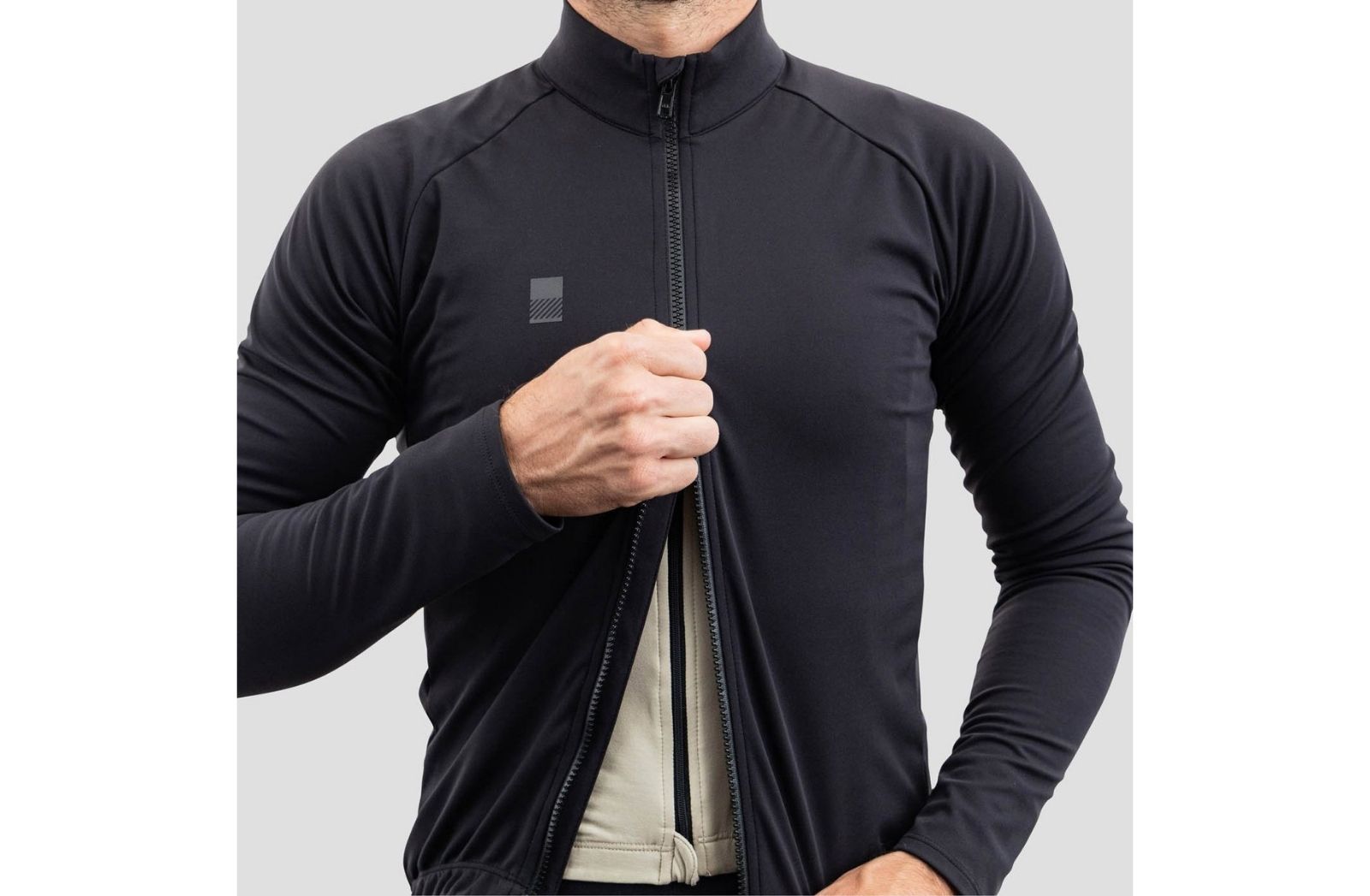
The Ornot Magic Shell jacket is the jacket that one BikeRumor editor chose to wear while racing The Rift in Iceland. It holds up to the coldest, sideway-est rain, sleet, and hail a Nordic summer can throw at you (which is surprisingly cold and sideways!).
It stretches, repels water fantastically well, and stuffs into a jersey pocket. It’s the perfect weight for most conditions, and we found that it’s insulating enough in the cold rain with layers underneath, but breathable and light enough for moderate temps too. Lastly, it has a very soft feel. It’s not crunchy or noisy like most rain shells, it’s very much a thin softshell that’s super comfortable while still being waterproof. Maybe that explains why it’s called the “Magic Shell.”
We love the full-width external zip pocket, something many cycling raincoats don’t have. That means it’s incredibly useful if you know you’re starting a ride in the pouring rain but want access to snacks and your phone. It’s also lightweight at 255 grams and has a two-way zipper so you can even access your jersey pockets for bonus snacks.
- Colors: Black, Morocco, Gravel
- Sizes: Men’s XS-XL / Women’s XS-XL
- Material: Polartec NeoShell fabric
- Weight: 255 g
- Men/Women options: Yes
- MSRP: $268
PROS: Incredibly comfortable
CONS: Might be a bit much for hot summer days
BEST OVERALL – WOMEN’S: 7mesh Skypilot
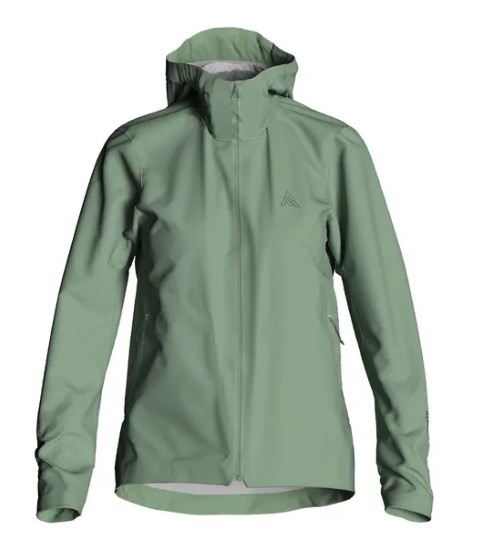
We were so impressed with the care that went into creating a well-fitting women’s-specific raincoat that we had to give it this designation.
Typically, it’s hard to find a women’s rain jacket that’s not just a different colorway, but 7mesh put the effort into creating a version of the Skypilot that took a woman’s body into account, making room in the chest while making it slightly shorter to fit women’s tendency toward shorter torsos compared to men. That means it fits like a dream: no breathing issues up top and no bunching issues at the waist.
It’s not as aero as some form-fitting jackets, but it won’t be flapping during road rides and you can fit layers underneath it.
We deeply appreciate the underarm zippers for perfect ventilation. 7mesh uses GORE-TEX to provide some of the best waterproofing while still being breathable — and the jacket delivers. In years of wearing (and washing), it hasn’t degraded at all.
- Colors: Fern, Midnight Blue
- Sizes: Women’s XS-XL; Men’s XS-XXL
- Material: GORE-TEX Pro
- Weight: 217 g
- Men/Women options: Yes
- MSRP: $370
PROS: Comfortable, thoughtful fit, great all-around
CONS: Limited colors, not ideal for roadies, expensive, not a removable hood
BEST COMMUTER: Chrome Storm Salute Commute
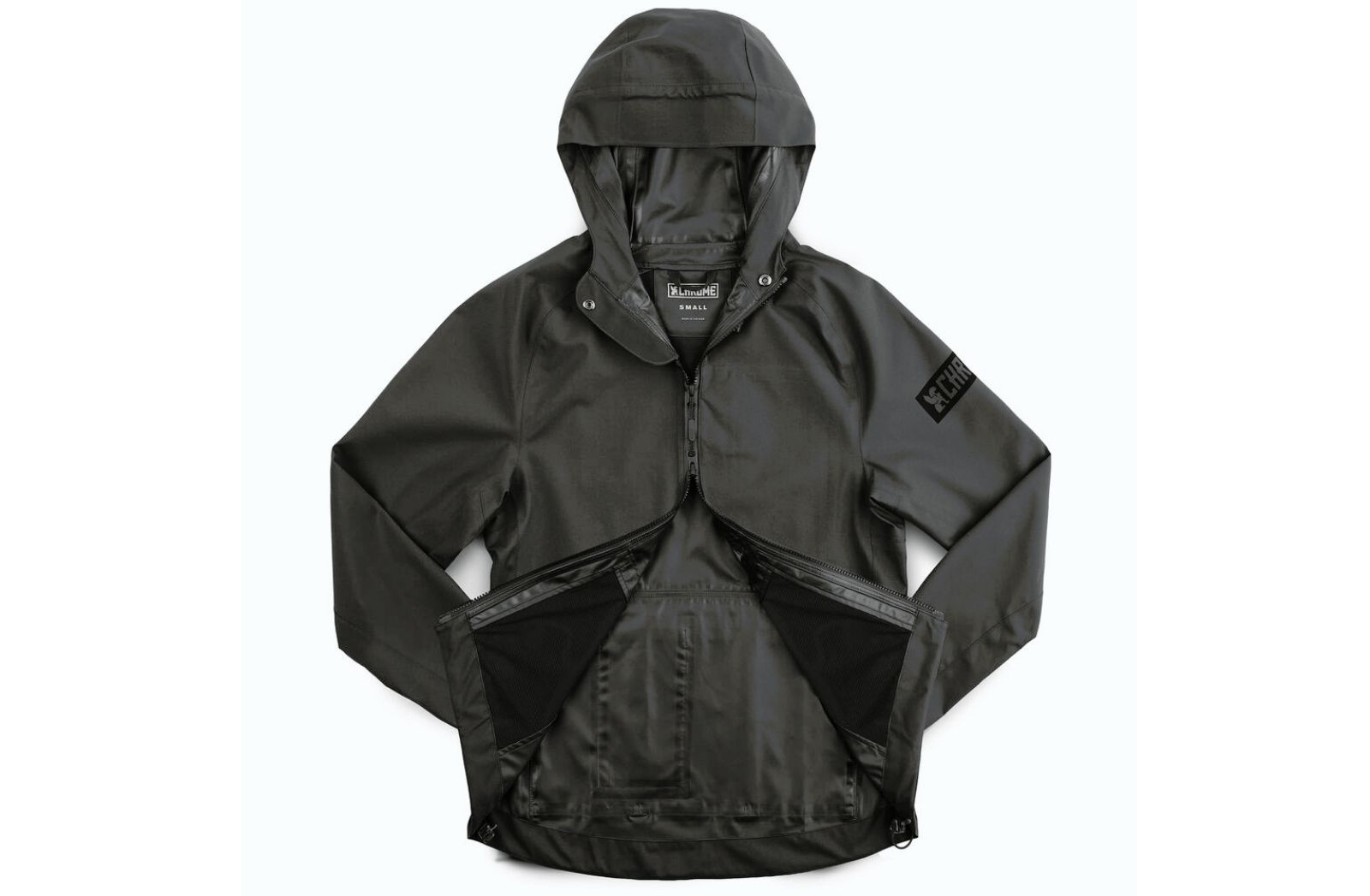
Looking for a raincoat that looks cool and feels comfortable wearing in everyday life, but is also designed to make your commute to work perfectly dry? Enter the Storm Salute Commute from Chrome, a messenger-chic urban raincoat that’s designed to be comfy on and off the bike.
There are men’s and women’s fits available, and both are feature-rich. The coat has an adjustable hood that can fit over a commuter helmet for downpour situations, a two-way zipper in case you need to get into a back pocket, and plenty of waterproof pockets that allow for phone storage on your ride. We also like the adjustable tail in the back: If you forget your fender, just unhook it and your butt will stay relatively protected from splash. It’s a comfortable fit, so you can squeeze a hoodie on under it — this editor has even worn it with a down jacket underneath in the winter with no issues.
It might sound shallow, but this BikeRumor editor appreciates how the jacket looks off the bike: It’s the only one that doesn’t scream “athletic wear!” — so if you’re running errands or rolling to the bar and want to feel less sporty, this is your best bet.
- Colors: Black and Olive
- Sizes: Men’s S-XXL; Women’s XS-XL
- Material: Polyester
- Men/Women options: Yes
- MSRP: $190
PROS: Comfortable and great for off the bike as well as on
CONS: Not for serious cycling, definitely a commuter jacket at heart
BEST PACKABLE: GORE SHAKEDRY
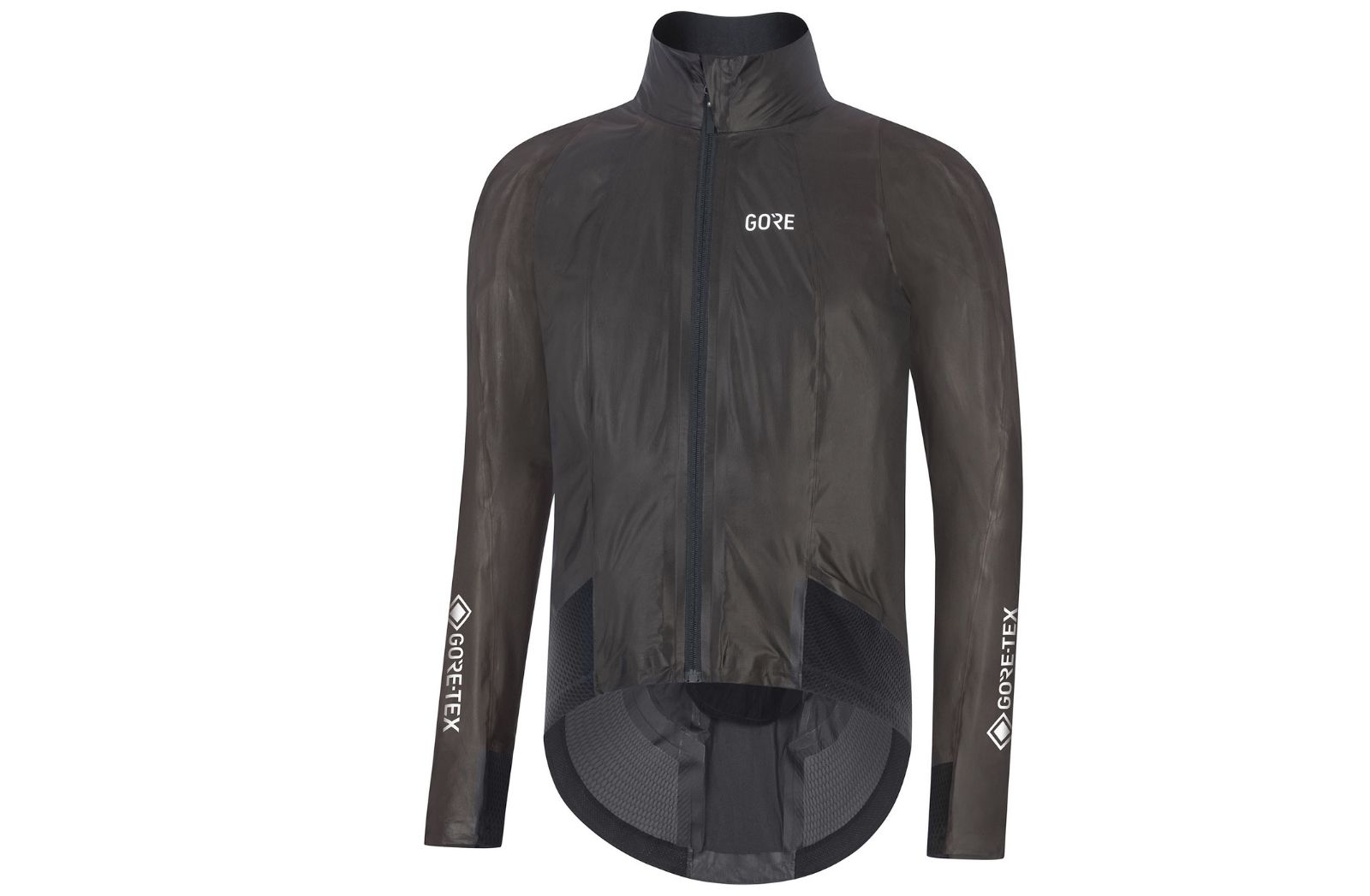
You simply can’t beat a GORE SHAKEDRY jacket for a packable jacket that can jam into a back pocket or a handlebar bag. These are the most roadie/racer friendly on this list, thanks to a lightweight and close fit. While it’s small, don’t be fooled: This jacket is mighty in performance benefits.
It uses subtle stretch panels to ensure the perfect fit, and we really appreciate the stretch at the wrists to ensure no rain comes in from between your gloves and the jacket. We also appreciate the cut: It’s shorter in the front and drops in the back to keep your butt a bit drier while optimizing aerodynamics in the front.
If you want to win your group ride, this is the jacket for you. It comes at a cost, but these jackets last a long time and hold up to any types of conditions. The only other potential downside: This jacket isn’t ideal off the bike because the fit has been optimized for a riding position rather than standing, so if you’re looking for a more all-around athletic raincoat, look for one with a bit more wiggle room. It also should not be worn with a backpack, as it’s not abrasion-proof.
If you prefer a more colorful option, Rapha has the exclusive ability to print SHAKEDRY in colors (at least for the time-being).
- Colors: Black
- Sizes: XS-XL
- Material: GORE SHAKEDRY
- Weight: 172 g
- Men/Women options: Men only, but similar women’s option is the C7 Women GORE-TEX SHAKEDRY
- MSRP: $295
PROS: Optimized for packability and perfect for aerodynamics
CONS: Pricey
BEST MTB RAINCOAT: Specialized Trail Series Rain Jacket
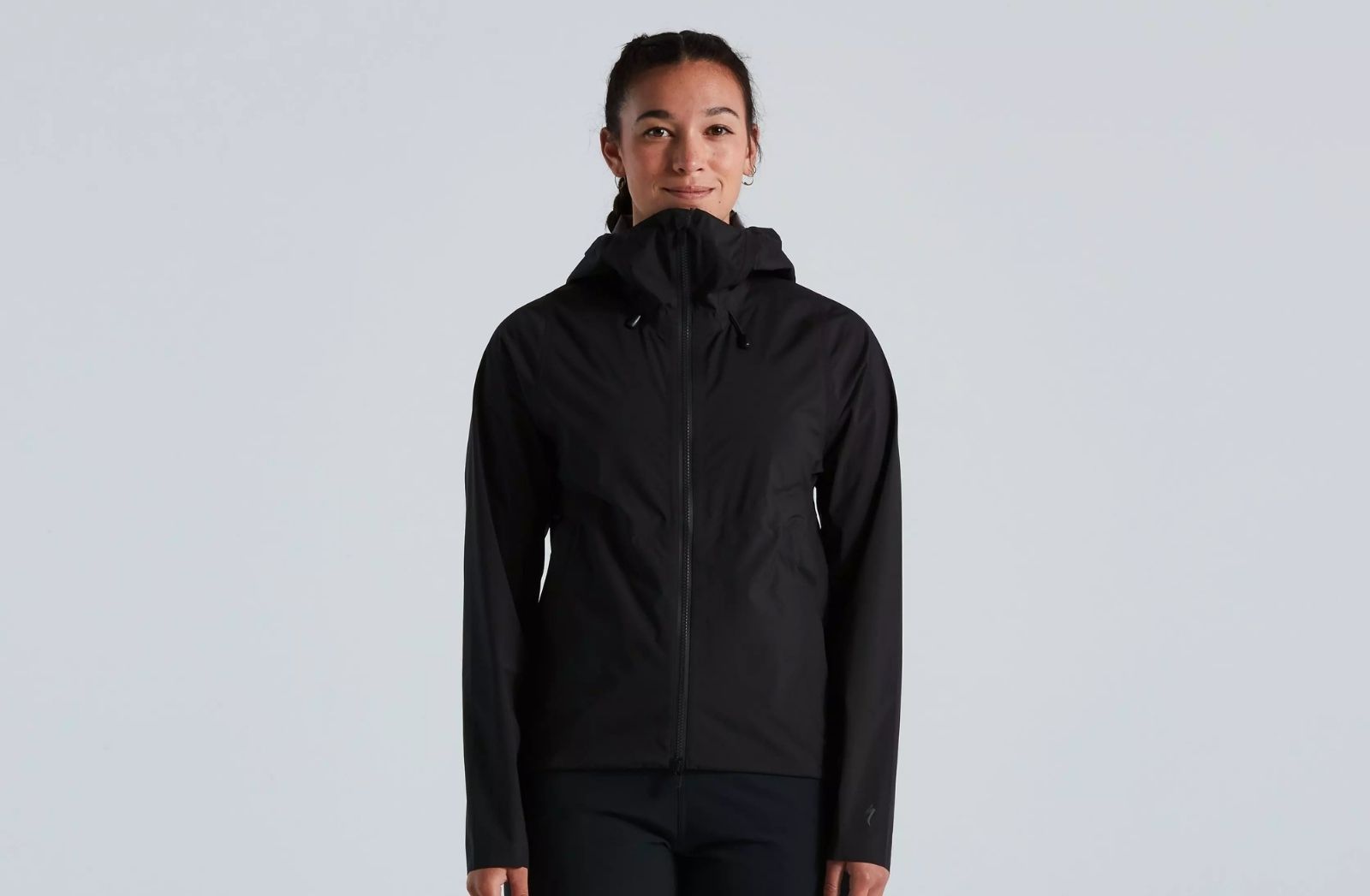
If you’re mountain biking, you might be less inclined to favor aerodynamics over comfort and a bit more durability. Because of that, we like Specialized women’s and men’s Trail Rain Jacket. Made with three-layer woven fabric with a laminated shell (more on that in the frequently asked questions below), the jackets are designed for breathability in addition to being waterproof.
Mountain bikers tend to prefer over-the-hood helmets since peripheral vision is less of an issue when shredding on singletrack versus riding busy roads. This jacket has a higher neck and a large hood with a rain visor, so if it starts pouring, you can fully cover up and avoid rain dripping down your back. The fit is much looser than a more road-focused cycling raincoat, but that makes it more comfortable on the trails as you move around — and in wet conditions, you’re more likely to be off your bike and running, so a jacket with a bit more room is helpful. (Read the full review here.)
Note: While there are men’s and women’s versions available, the men’s version is pricier but comes with some upgrades, like the use of Polartec NeoShell in the fabric.
- Colors: Black
- Sizes: XS-XXL
- Material: Men’s: Polartec NeoShell / Women’s: polyester
- Men/Women options: Yes
- MSRP: Men’s: $375 / Women’s: $225
PROS: Great hood for trail rides in the rain
CONS: Looser fit
BEST MID RANGE: Giro Men’s Chrono Expert Rain Jacket
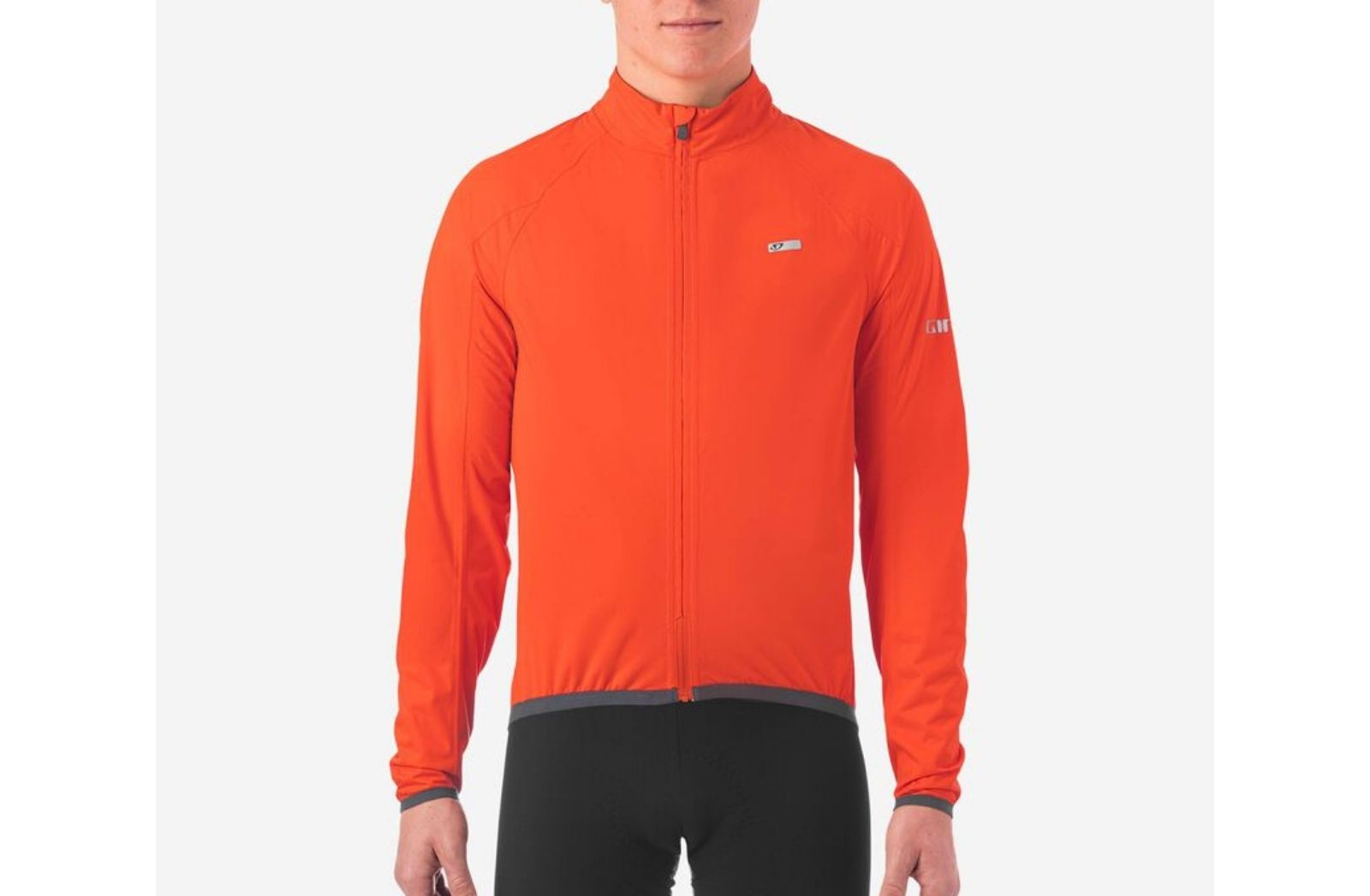
The Chrono Expert Rain Jacket from Giro is a great midrange option for someone who wants a lightweight roadie-friendly aerodynamic raincoat but can’t handle the $350+ price tag of some of the higher-end options. We appreciate the stretch that makes it a close fit without being too tight, as well as the handy vents to improve breathability.
It’s also one of the most waterproof options on this list while maintaining enough breathability that even during a tough race, you won’t feel like you’re wearing a sauna suit. It’s one of the few raincoats that combine laminate waterproofing technologies with a DWR coating to maximize the amount of protection you’ll have in the most epic of downpours. And it’s small enough to jam into a back pocket in a pinch, though not quite as packable as the GORE SHAKEDRY options.
- Colors: Black, orange
- Sizes: Men’s S-XXL / Women’s XS-XL
- Material: 100% polyester
- Men/Women options: Yes
- MSRP: $165
PROS: Great rain jacket for the price
CONS: Close fit may not appeal to some, no pockets
BEST BUDGET: O2 Original Cycling Rain Jacket
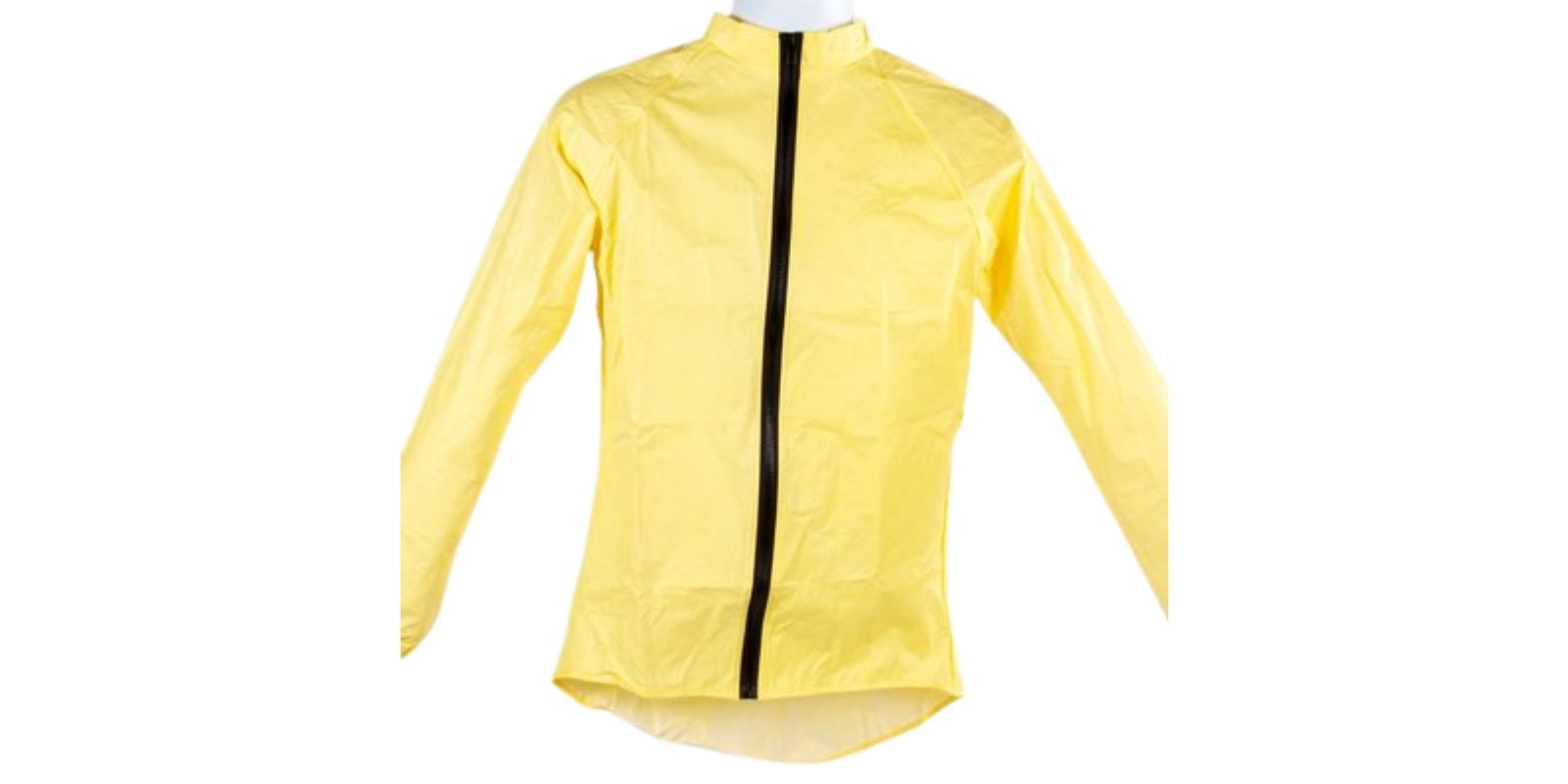
At $40, this jacket from O2 seems too good to be true, but one staffer has had his for over a decade and proclaims it the best packable jacket out there. While it doesn’t have any bells or whistles, this simple jacket is hi-vis — it’s only available in canary yellow — and can jam into any handlebar bag (it even comes with its own stuffsack). If you want an emergency raincoat but don’t want to break the bank, this is your pick.
Now, we don’t want to oversell this jacket. Don’t expect this to fit like a glove, or to hold up perfectly if you crash on the road or into a cactus on the mountain bike. It’s not the most breathable jacket out there; it’s primarily made with polypropylene, a plastic, and feels like it. But if you’re just getting started and the idea of riding in the rain seems interesting but not like something you want to do on a daily basis, this one is worth the (minimal) spend.
- Colors: Yellow
- Sizes: S-XXL
- Material: Polypropylene
- Weight: 113 g
- Men/Women options: No
- MSRP: $40
PROS: Super lightweight and affordable
CONS: Won’t be the best fit or most breathable
BEST HIGH-TECH: Showers Pass Hi-Vis Elite E-Bike Jacket
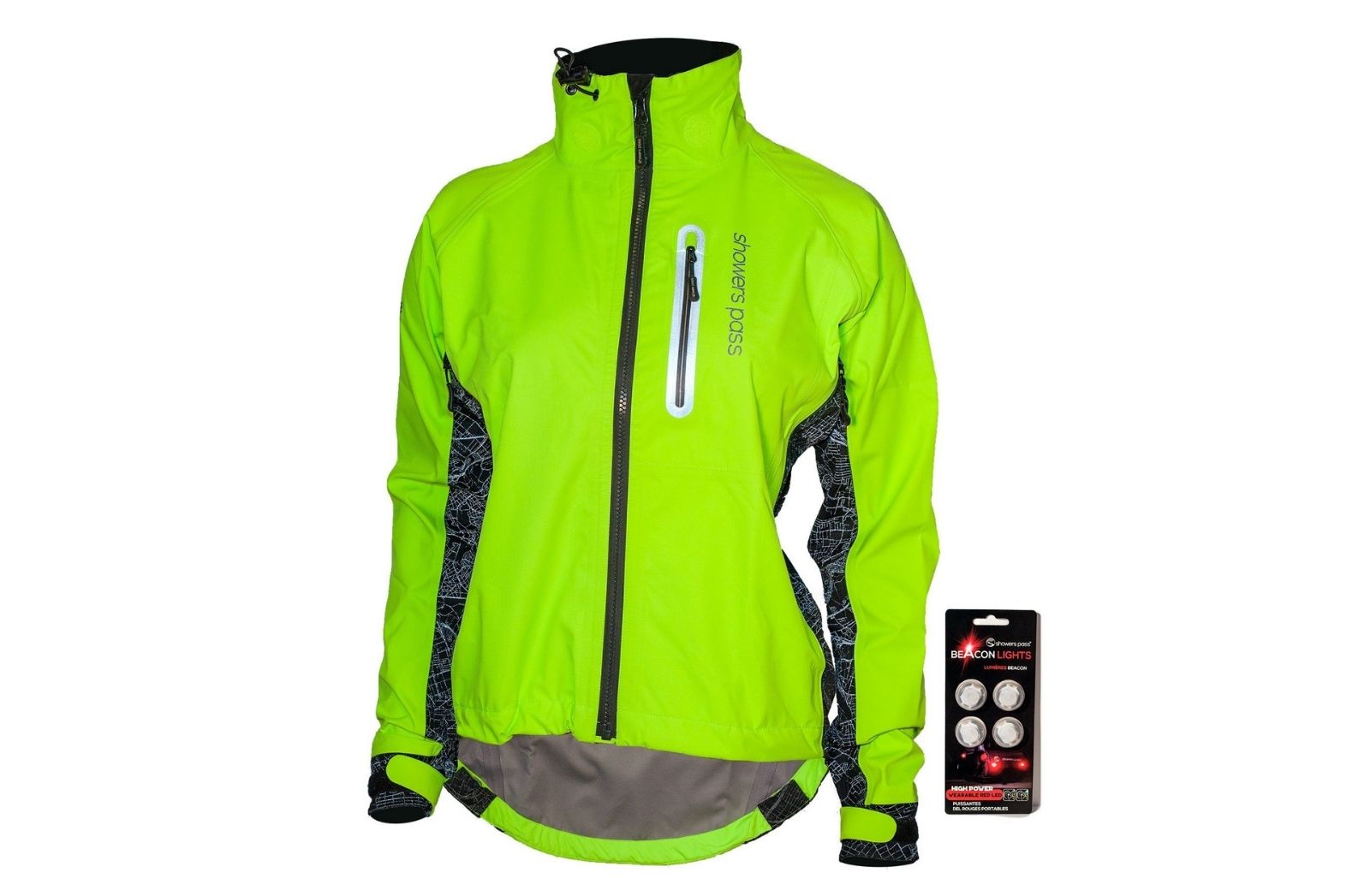
If you ride in a city, riding in the rain isn’t just about staying dry, it’s about staying visible. Enter the ridiculously hi-vis Showers Pass Hi-Vis Elite, which combines Showers Pass’s best raincoat technology with the ultimate in see-and-be-seen additions. From the ultra-vibrant highlighter yellow color that’s incredibly reflective to reflective silver side panels to battery-powered red LED beacon lights that come with it and can clip onto grommets on the cuffs and back of the coat, you’re basically a pedaling billboard for bike safety.
But the jacket is also comfortable: It’s breathable, cozy, and incredibly waterproof. Getting steamy? Adjust by opening the vents or loosening the wrist cuffs. It features a chest pocket with an audio port if you need headphones on to navigate, and has a large pocket in the back for your valuables. And while it doesn’t come with a hood, Showers Pass has a hood that can be purchased separately that can clip on.
Just note that this jacket is popular and is often low in inventory — if you don’t mind keeping an eye on it, it’s well worth the wait for a restock.
- Colors: Hi-vis yellow
- Sizes: S-XXL
- Material: Breathable Elite three-layer ripstop fabric with brushed lining, MapReflect
- Weight: 510 g
- Men/Women options: Men and Women’s available (Women’s pictured)
- MSRP: $270
PROS: The ultimate in hi-vis while riding in the rain
CONS: Not great if you don’t want to be ultra-hi-vis
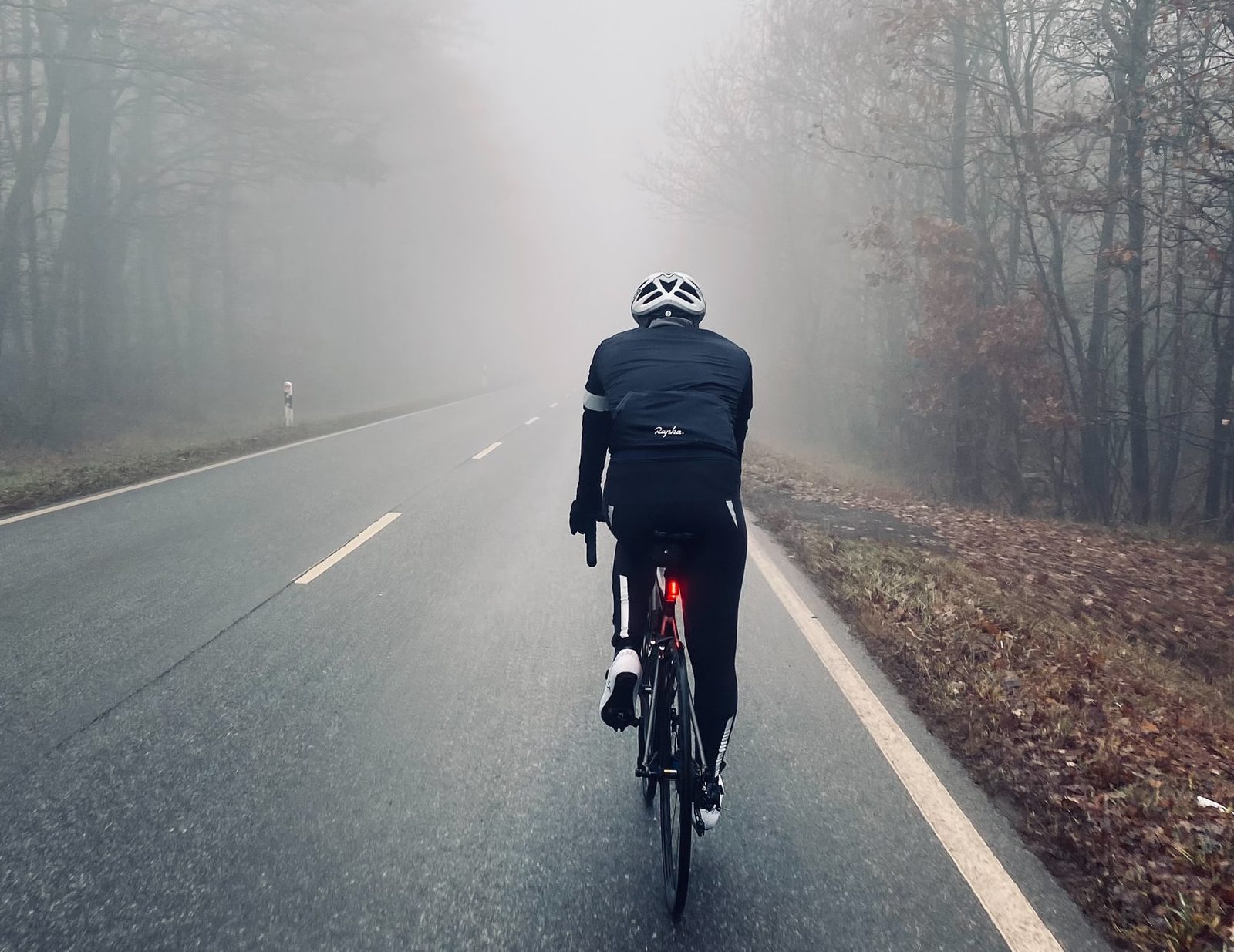
Cycling Rain Jacket Buyers Guide
Riding Style
If you’re commuting, a slightly bigger raincoat with more coverage and a hood is ideal, while for road or mountain biking, a closer fit may be preferable. There are also “packable” versus regular raincoats. A packable raincoat is great for occasionally getting caught in a shower while on a ride, and can be tucked into a jersey pocket. But a regular raincoat capable of withstanding any type of deluge will be a bit heavier and less foldable.
Fit
Look for a coat that feels comfortable when in the position you ride in (pedal around on your bike in dry weather to test a jacket’s fit before committing to it). You shouldn’t feel restricted at all, though you do want a close fit.
Pockets
Consider if you want a zippered pocket to protect your phone or to have easy access to any snacks that you would normally keep in a jersey pocket. Most higher-quality coats will have at least one zippered pocket.
Zippers
It’s hard to tell if a zipper is high quality or not, but if you’re testing your coat before committing to it, make sure the zipper is easy to use and feels smooth. You may also be looking for zippers that provide ventilation, typically on the sides/underarms. These additions can make a ride much more comfortable and less sweaty.
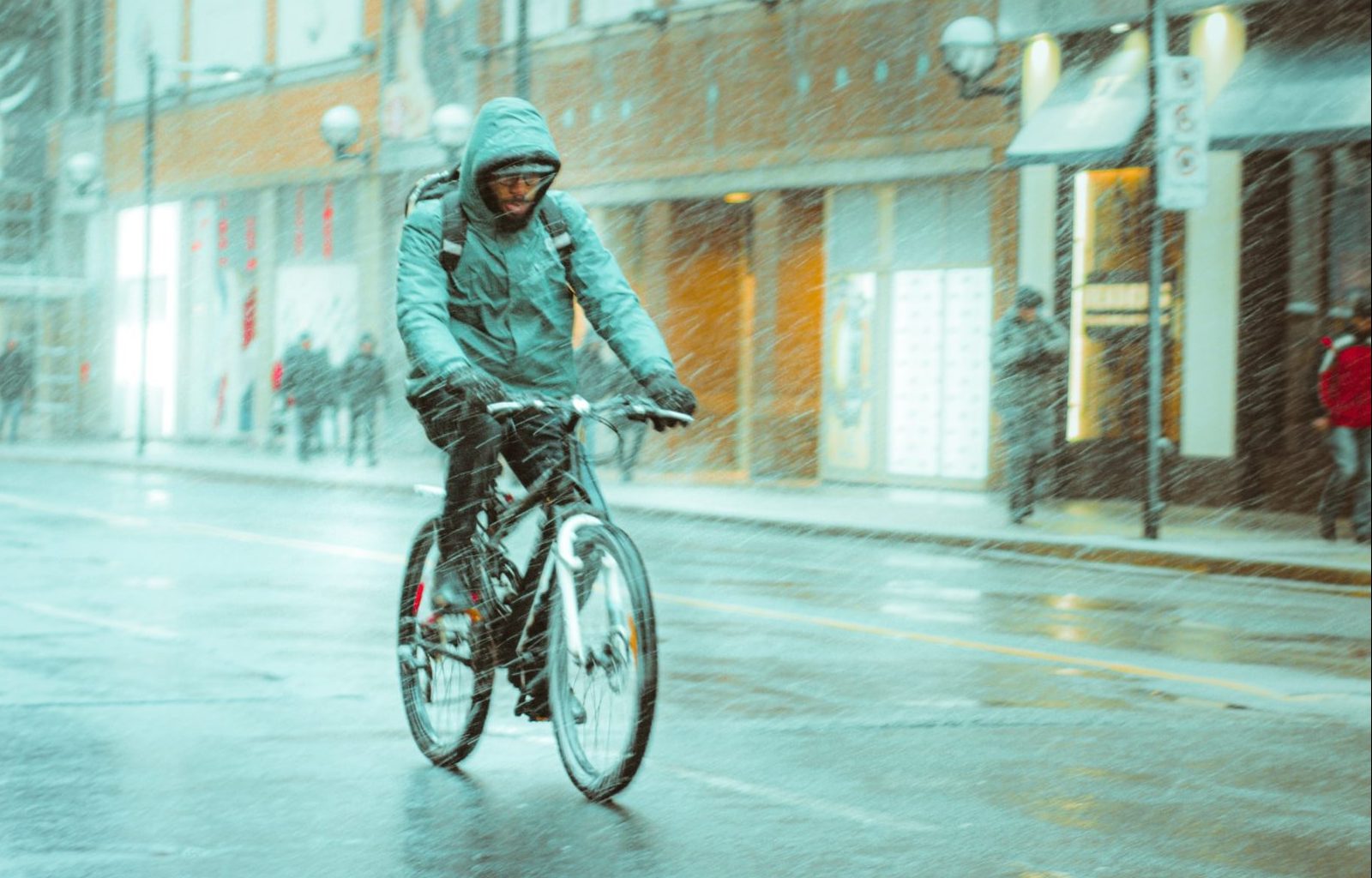
Back Flap
A back flap that folds down isn’t essential, but for someone who doesn’t have a rear fender or regularly commutes using a bike share, a back flap can be a great way to protect your butt from spray coming up from your rear wheel. It’s not a perfect solution — a fender is a much better investment — but it can be a nice addition to a raincoat.
Reflective Accents
Like a back flap won’t replace a fender, reflective accents won’t replace having a rear or front light on your bike to improve visibility, but can help in a pinch. Don’t choose a jacket based on its reflective abilities, but take them into consideration.
Hood
We’ll talk more about hoods in the section below, but it’s worth considering whether or not you want a hood on your raincoat. But our preference is for a removable hood since that makes a raincoat much more versatile.
Packability
Again, if you’re looking for a raincoat that can stuff into a jersey pocket or a handlebar bag on your bike, look for a coat that’s lightweight and packable. If a description doesn’t mention either of those qualities, it likely won’t stuff into anything easily.
Price
If you’re on a budget, there are some great options out there, but you may find that after a season, you need to invest in re-treating it with a waterproofing spray. (More on that below.) Raincoats are an essential piece of gear for cyclists who want to ride in all conditions, so if you are serious about cycling, we recommend spending a bit more on a jacket that fits great and will last a long time.
Returns and Warranties
Check the brand’s return, repair, and warranty options before you buy, especially if you’re not positive about sizing.
Frequently Asked Questions About Cycling Raincoats
How should a cycling raincoat fit?
It depends on how you’re using it. If you’re riding on the road or MTB and have a need for speed, then you’re going to want a raincoat that fits close to your body to minimize air resistance. But if you’re looking for a raincoat as a commuter, you want a coat that fits close to the body but allows room for your regular clothing underneath it. The temperatures you ride in are also a consideration: If you’re looking for a raincoat that you can wear in the winter, you’ll want one that can fit a cycling jacket or at least a base layer and long-sleeve jersey underneath it while still allowing you to breathe comfortably.
Don’t forget to try your raincoat on with the kit you’ll be wearing under it, and test it in the position you stay in while riding: bent at the hips, arms bent to grab the handlebars. This can change how comfortable a jacket is, so if you’re trying one on in a store, remember that your jacket should fit best when in the cycling position, not when standing upright.
Do I need a different coat for MTB versus road?
The fit may differ slightly between the two, and a raincoat designed for road cycling will likely be a bit lighter, tighter, and a bit less burly. A mountain bike raincoat, on the other hand, will tend to be a bit thicker, since you’re more likely to bounce off of trees or take small spills on the mountain bike, and you don’t want a raincoat that’s light enough to rip as soon as you fall and land on some thorns.
Do I need a women’s cycling raincoat?
You don’t, though some women — especially those with larger chests or shorter torsos — may prefer the fit of a women’s raincoat, especially if you’re looking for a close fit.
What kind of features should I look for in a cycling raincoat?
It depends on what kind of raincoat you’re looking for. If you want one that can stuff into a jersey pocket and be used for “emergencies,” then focus on finding something lightweight with no bells or whistles. But if you’re looking for a raincoat that you would start a ride in, things like watertight pockets, reflective accents, and a longer back or flap that folds down can be great features.
What should I do if my raincoat rips?
While you can opt to patch it yourself with a patch kit like this one, we recommend contacting the manufacturer directly first. Some may have in-house free repairs or offer replacements depending on the situation.
What does the waterproof rating mean?
Waterproof ratings get a bit confusing. A piece of fabric is tested by hanging a tube of water over the fabric. The water is dripped onto the fabric at increasing heights and the water’s height in millimeters when leakage through the fabric is the waterproof rating. To be considered waterproof, even the lightest of cycling raincoats must have a rating of 1,500 mm. But serious raincoats for stormy rides can have waterproof ratings of over 10,000 mm! (Note: Not all brands provide the precise waterproof rating.)
Why would I want a lower waterproof rating?
Remember, air and water go in both directions. If a jacket is ultra-waterproof, it means it won’t be as breathable, so if you’re a heavy sweater or ride in warm conditions, you might want a rain jacket that is more breathable, even if it’s less watertight.
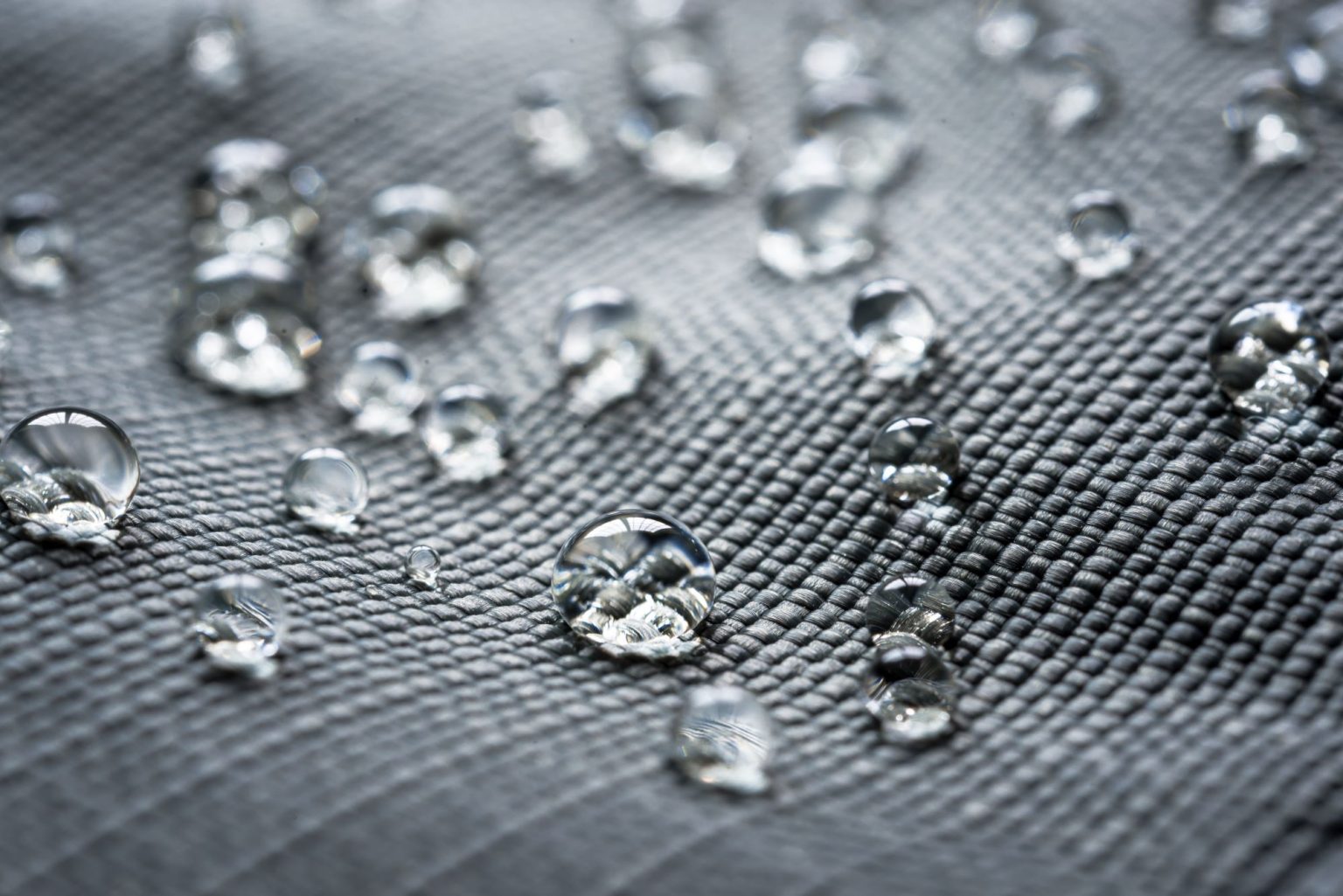
What’s the deal with DWR versus laminate?
Here’s the deal: Durable water repellent (DWR) treatments are applied to the fabric to make a fabric more waterproof. They degrade over time, which is why you may need to retreat some raincoats after many wears and washes. You may see some random numbers noted when brands talk about their DWR fabrics, like 30/50. That means after 50 washes (the second number), the DWR is about 30 percent as effective as it was when it was new. Of course, you won’t be washing your raincoat often, so don’t panic that your raincoat has only 50 uses before it stops being water-resistant!
A laminate, on the other hand, is a physical thin layer of cover that’s applied to the surface of a fabric. It’s either Teflon or polyurethane and typically lasts longer than a DWR treatment because it’s glued over top of the fabric. Many use two or three layers of laminate to add more protection.
Are there any good eco-friendly DWR treatments to re-treat rain gear?
Endura’s PFC-Free Re-Proofer is a new entry to the market as brands try to eliminate perfluorochemicals, a group of synthetic chemicals known for water and oil repellency, from their product lines. Nikwax is another great option that avoids using harmful chemicals while still making gear more waterproof. We recently tried Endura’s eco-friendly DWR spray and found it was a great way to breathe new life into rainwear that’s started to get a little less waterproof than it used to be.
Do I need a hood?
We like a jacket that has a removable hood because, to be honest, hoods can be more trouble than they’re worth. Some hoods are large enough to wear over your helmet — like the Chrome Storm Seeker for commuters — but in most situations, you wouldn’t want to block your peripheral vision. Some people opt to wear them under a helmet, but that can be uncomfortable and may minimize vision. And of course, a hood will add to the overall weight of a coat and make it less packable.
Still, a hood can be nice, especially if you’re also wearing the jacket off the bike. For instance, you may wear a rain jacket while warming up at a cyclocross race without the hood, and then want to put a hood up while you stand and spectate after your race is done. A removable hood provides the best of both worlds — but ultimately, don’t stress if your raincoat of choice doesn’t have one.
Do I need to bring a cycling raincoat on every ride?
It’s probably not worth bringing one along on a summer ride unless you’re expecting storms. Getting caught in a shower is just one of the many joys of being out on the bike! But if temperatures are below 65ºF, you should bring one if there’s a good chance of rain. While 65ºF may not seem too chilly, if you’re riding quickly on the road and you’re soaked, it can feel quite cold!
